Almost Done!

Fingers crossed this will be the last post of the Hydra Chronicles, a.k.a. “Everything You Didn’t Want To Know About Group Statistics But Let Me Tell You Anyway”. Well, it’s more of a salvage job of tidbits from earlier posts that ended up on the cutting room floor that I couldn’t quite bring myself to trash.
One of our early “discoveries” about group statistics is that if we can compute
the group sum quickly, we can use it to compute many other group statistics
quickly as well. In this post we’ll go over a few of the other group sum
strategies I tested out before I settled on the cumsum based approach
we used to “beat” data.table.
rowsum
I did mention this one in passing, but it bears re-examining:
base::rowsum is a remarkable creature in the R ecosystem. As far as I know,
it is the only base R function that computes group statistics on unequal group
sizes in statically compiled code. Despite this it is arcane, especially when
compared with its popular cousin base::rowSums.
rowsum and rowSums are near indistinguishable on name alone, but they
do quite different things. rowsum collapses rows together by group, leaving
column count unchanged, whereas rowSums collapses all columns leaving row
count unchanged:

In the single column/vector case, rowsum(x, grp) computes the sum of x by
the groups in grp. Typically this operation is done with tapply(x, grp, sum) (or vapply(split(x, grp), sum, 0)):
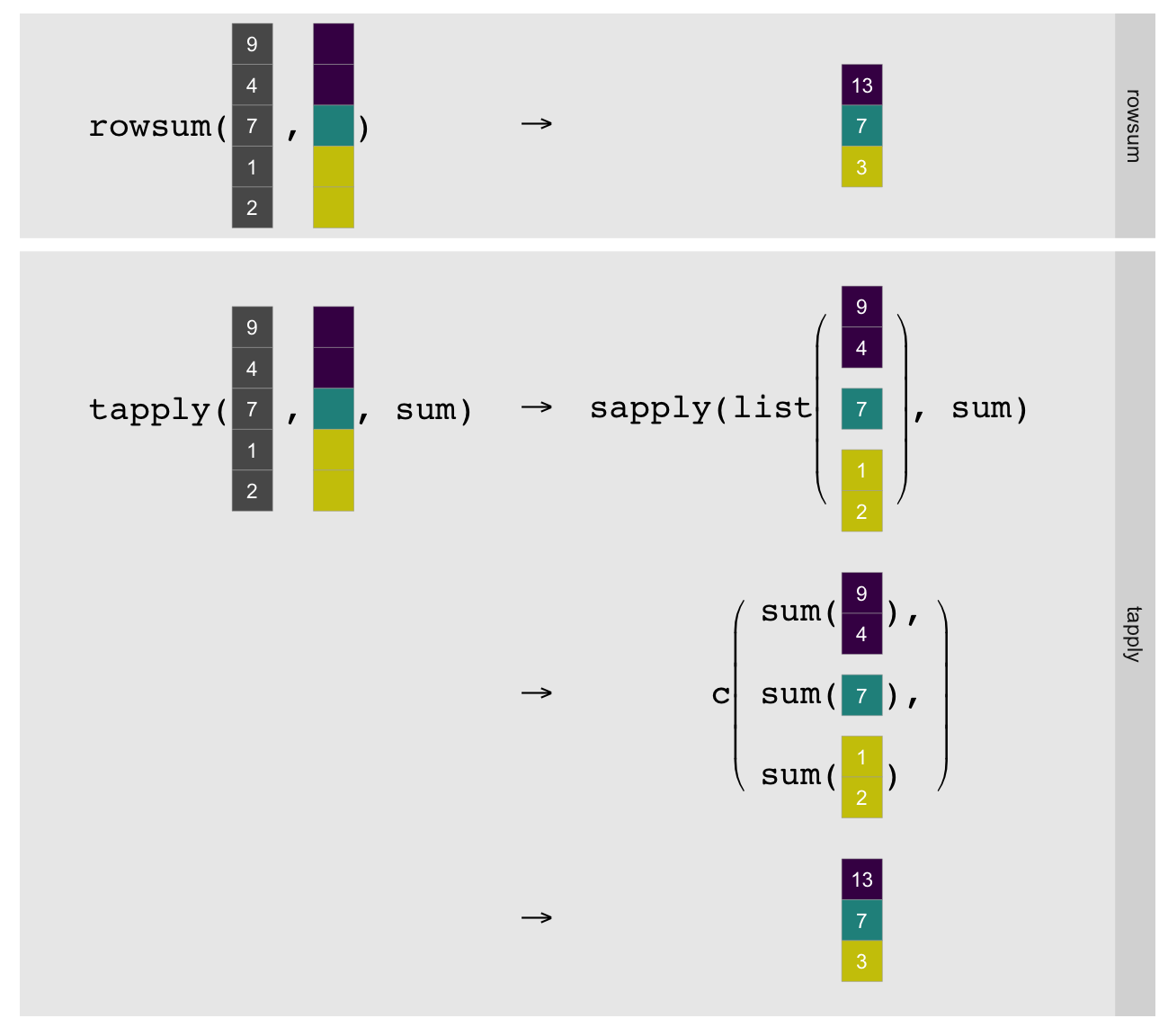
As illustrated above tapply must split the vector by group, explicitly call
the R-level sum on each group, and simplify the result to a
vector1. rowsum can just compute the group sums directly in
statically compiled code. This makes it substantially faster, although
obviously limits it to computing sums.
Let’s look at some examples and timings with our beaten-to-death 10MM row, ~1MM
group data set, and our timing function sys.time. We’ll
order the data first as that is fastest even when including the time to
order:
sys.time({
o <- order(grp)
go <- grp[o]
xo <- x[o]
}) user system elapsed
0.690 0.003 0.696tapply for reference:
sys.time(gsum.0 <- tapply(xo, go, sum)) user system elapsed
2.273 0.105 2.383And now rowsum:
sys.time(gsum.1 <- rowsum(xo, go)) user system elapsed
0.507 0.038 0.546all.equal(c(gsum.0), c(gsum.1), check.attributes=FALSE)[1] TRUEThis is a ~4-5x speedup for the summing step, or a ~3x speedup if we include the
time to order. data.table is faster for this task.
All
data.tabletimings are single threaded (setDTthreads(1))2.
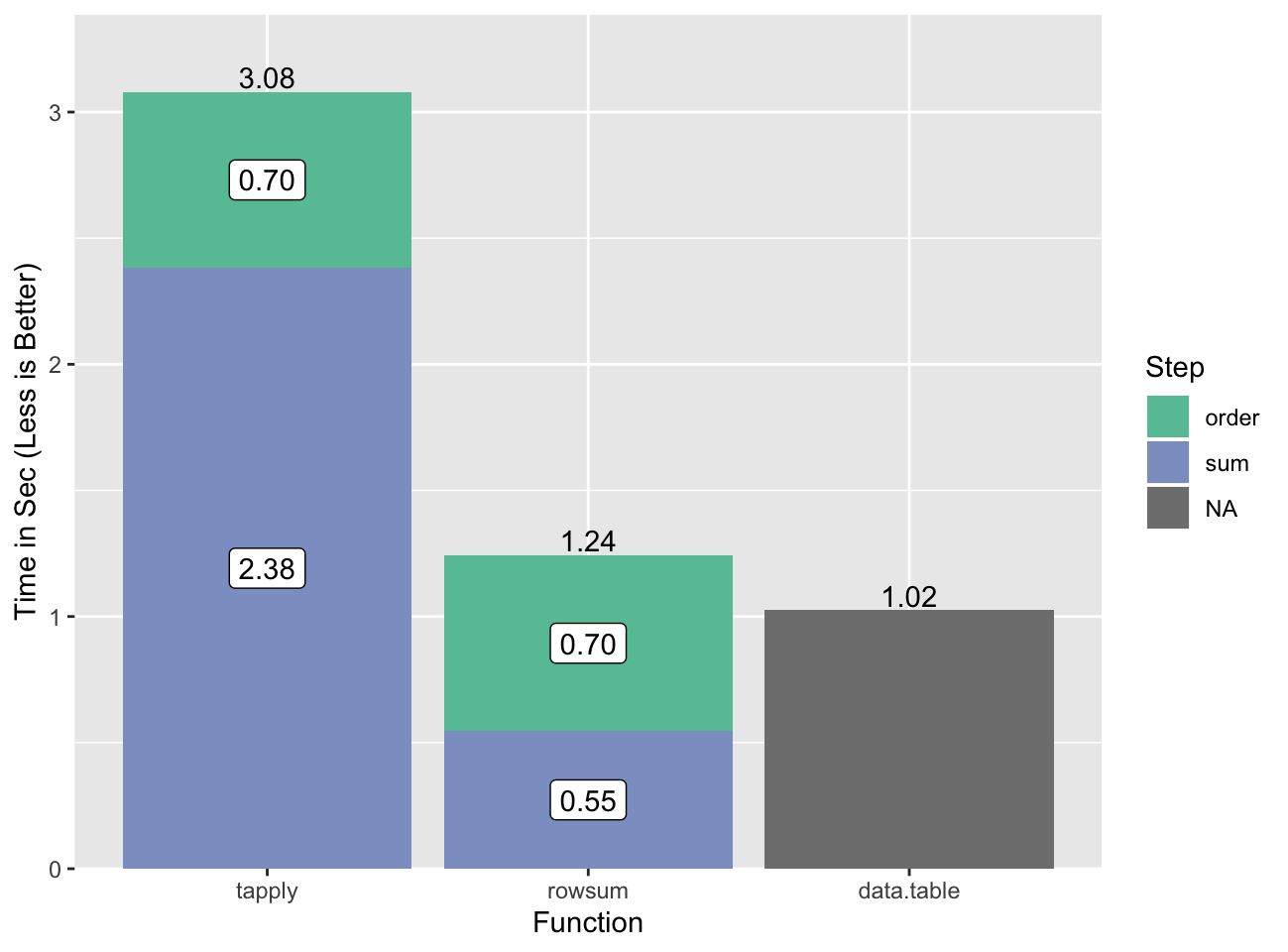
The slow step for data.table is also the ordering, but we don’t have a
good way to break that out.
colSums
base::rowSums, the aforementioned better-known cousin of rowsum, also
computes group statistics with statically compiled code. Well, it kind of does
if you consider matrix rows to be groups. base::colSums does the same except
for columns. Suppose we have three equal sized ordered groups:
(G <- rep(1:3, each=2))[1] 1 1 2 2 3 3And values that belong to them:
set.seed(1)
(a <- runif(6))[1] 0.266 0.372 0.573 0.908 0.202 0.898We can compute the group sums using colSums by wrapping our vector into a
matrix with as many columns as there are groups. Since R internally stores
matrices as vectors in column-major order, this is a natural operation (and also
why we use colSums instead of rowSums):
(a.mx <- matrix(a, ncol=length(unique(G)))) [,1] [,2] [,3]
[1,] 0.266 0.573 0.202
[2,] 0.372 0.908 0.898colSums(a.mx)[1] 0.638 1.481 1.100This is equivalent to3:
c(rowsum(a, G))[1] 0.638 1.481 1.100We run into problems as soon as we have uneven group lengths, but there is a workaround. The idea is to use clever indexing to embed the values associated with each group into columns of a matrix. We illustrate this process with a vector with 95 elements in ten groups. For display purposes we wrap the vector column-wise every ten elements, and designate the groups by a color. The values of the vector are represented by the tile heights:
You can also view the flipbook as a video if you prefer.
The embedding step warrants additional explanation. The trick is to generate a vector that maps the positions from our irregular vector into the regular matrix. There are several ways we can do this, but the one that we’ll use today takes advantage of the underlying vector nature of matrices. In particular, we will index into our matrices as if they were vectors, e.g.:
(b <- 1:4)[1] 1 2 3 4(b.mx <- matrix(b, nrow=2)) [,1] [,2]
[1,] 1 3
[2,] 2 4b[3][1] 3b.mx[1, 2] # matrix indexing[1] 3b.mx[3] # vector indexing on matrix[1] 3Let’s look at our 95 data before and after embedding, showing the indices in vector format for both our ordered vector (left) and the target matrix (right):
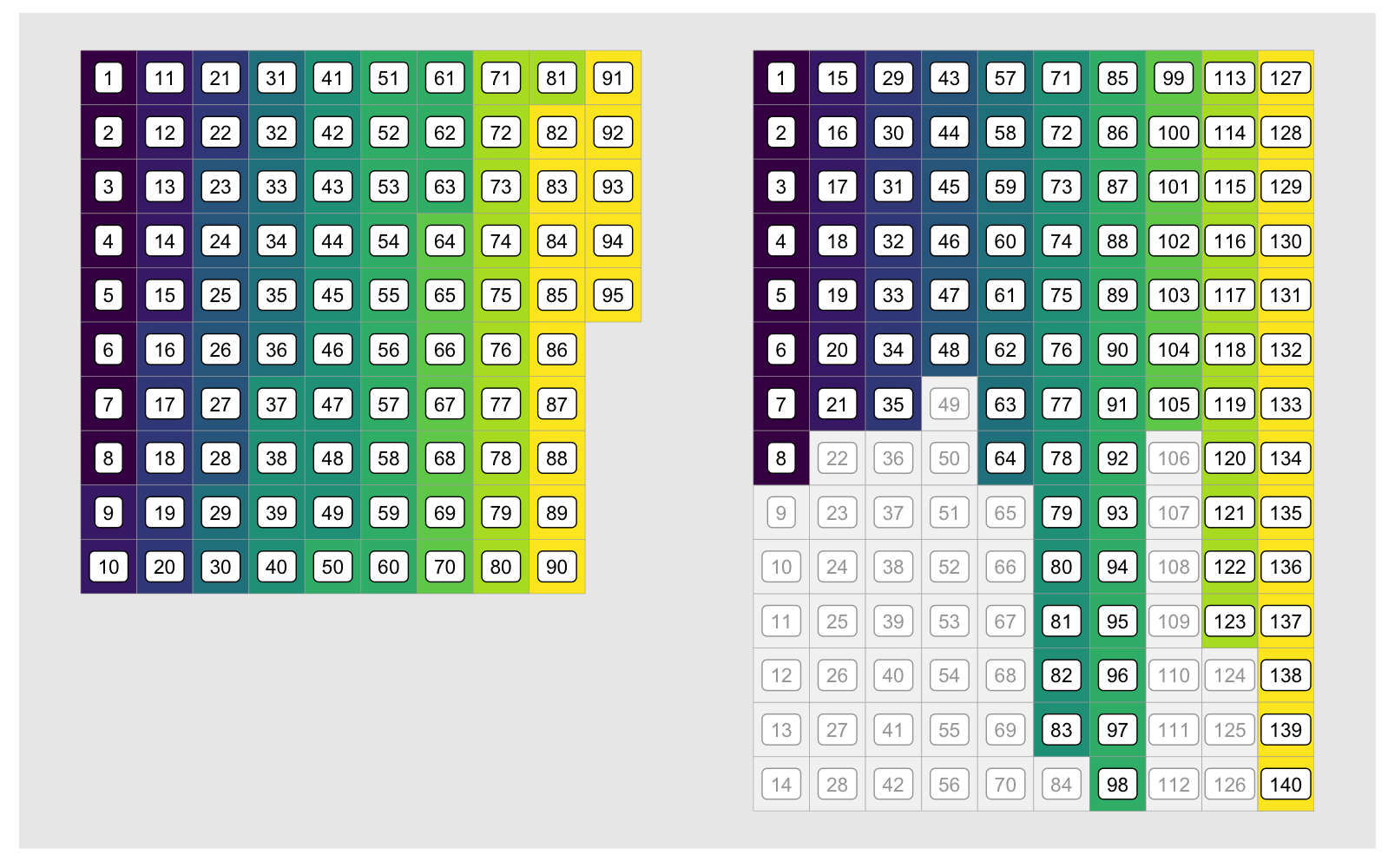
The indices corresponding to each group diverge after the first group due
to the unused elements of the embedding matrix, shown in grey above. What we’re
looking for is a fast way to generate the indices in the colored cells in the
matrix on the right. In other words, we want to generate the id1 (id.embed
in the animation) vector below. For clarity we only show it for the first three
groups:
 We can emphasize the relationship between these by looking at the element by
element difference in each index vector, e.g. using
We can emphasize the relationship between these by looking at the element by
element difference in each index vector, e.g. using diff:

The indices always increment by one, except at group transitions for the
embedding indices as shown in green above. There they increment by $1 + pad$.
“$pad$” is how much empty space there is between the end of the group and the
end of the column it is embedded in. The name of the game is to compute
“$pad$”, which thankfully we can easily do by using the output of rle:
g.rle <- rle(sort(g))
g.rleRun Length Encoding
lengths: int [1:10] 8 7 7 6 8 13 14 7 11 14
values : int [1:10] 1 2 3 4 5 6 7 8 9 10rle gives us the length of runs of repeated values, which in our sorted group
vector gives us the size of each group. Padding is then the difference between
each group’s size and that of the largest group:
g.max <- max(g.rle[['lengths']]) # largest group
(pad <- g.max - g.rle[['lengths']]) [1] 6 7 7 8 6 1 0 7 3 0To compute the embedding vector we start by a vector of the differences which as a baseline are all 1:
id0 <- rep(1L, length(g))We then add the padding at each group transition. Conveniently, the group transitions are just one element past the length of the previous element, so we can add the padding at the positions following the cumulative sum of the group lengths:
id0[cumsum(g.rle[['lengths']]) + 1L] <- pad + 1L
head(id0, 22) # first three groups [1] 1 1 1 1 1 1 1 1 7 1 1 1 1 1 1 8 1 1 1 1 1 1You’ll notice this is essentially the same thing as diff(id1) from
earlier. We reproduce id1 by applying cumsum:
head(cumsum(id0), 22) [1] 1 2 3 4 5 6 7 8 15 16 17 18 19 20 21 29 30 31 32 33 34 35A distinguishing feature of these manipulations other than possibly inducing death-by-boredom is that they are all in fast vectorized code. This gives us another reasonably fast group sum function. We split it up into a function that calculates the embedding indices and one that does the embedding and sum, for reasons that will become obvious later. Assuming sorted inputs4:
sys.time({
emb <- og_embed_dat(go) # compute embedding indices
og_sum_col(xo, emb) # use them to compute colSums
}) user system elapsed
0.502 0.195 0.699Most of the run time is actually the embedding index calculation:
sys.time(emb <- og_embed_dat(go)) user system elapsed
0.369 0.141 0.510One drawback is the obvious wasted memory taken up by the padding in the embedding matrix. This could become problematically large if a small number of groups are much larger than the rest. It may be possible to mitigate this by breaking up the data into by group size5.
Overall this is a little slower than rowsum for the simple group sum, but
as we’ll see shortly there are benefits to this approach.
Pedal To The Metal
For the sake of an absolute benchmark I wrote a C version of rowsum,
og_sum_C that takes advantage of group-ordered data to compute the
group sums and counts6. Once the data is sorted, this takes
virtually no time:
sys.time(og_sum_C(xo, go)) user system elapsed
0.039 0.001 0.041The only way to make this substantially faster is to make the sorting faster, or come up with an algorithm that can do the group sums without sorting and somehow do it faster than what we have here. Both of these are beyond my reach.
Let’s compare against all the different methods, including the original
cumsum based group sum (cumsum-1), and the precision corrected two
pass version (cumsum-2):
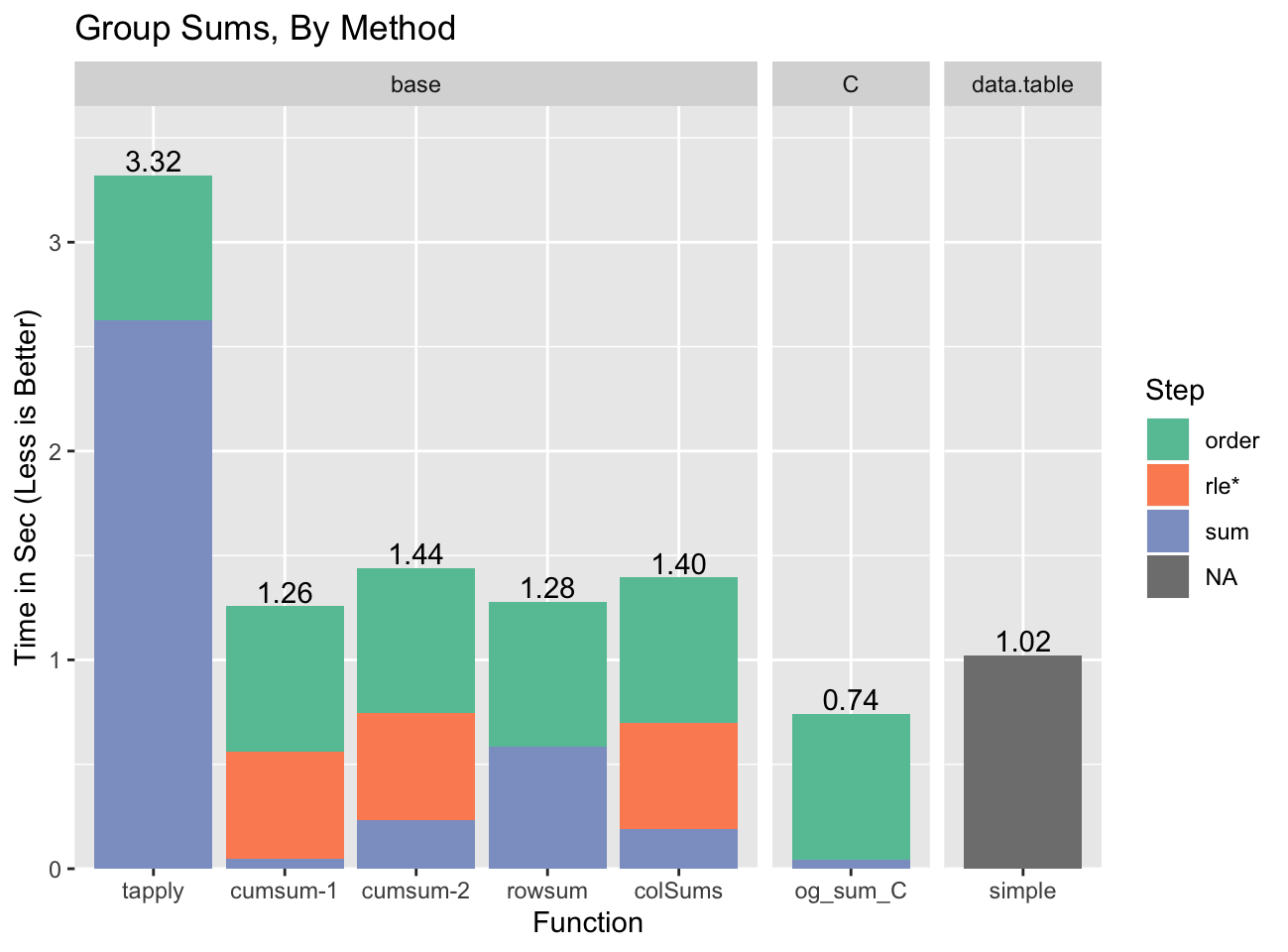
We’re actually able to beat data.table with our custom C code, although that
is only possible because data.table contributed its fast radix sort to
R, and data.table requires more complex code to be able to run a broader
set of statistics.
The pattern to notice is that for several of the methods the time spent
doing the actual summing is small7. For example, for colSums
most of the time is ordering and computing the run length encoding / embedding
indices (rle*). This is important because those parts can be re-used if the
grouping is the same across several calculations. It doesn’t help for single
variable group sums, but if we have more variables or more complex statistics it
becomes a factor.
Let’s see how helpful re-using the group-based data is with the calculation of the slope of a bivariate regression:
\[\frac{\sum(x_i - \bar{x})(y_i - \bar{y})}{\sum(x_i - \bar{x})^{2}}\]
The calculation requires four group sums, two to compute $\bar{x}$ and
$\bar{y}$, and another two shown explicitly with the $\sum$ symbol. At the
same time we only need to compute the ordering and the rle / embedding once
because the grouping is the same across all calculations. You can see this
clearly in the colSums based group slope calculation in the
appendix.
When we compare all the previous implementations of the group slope
calculation, against the new rowsum and colSums implementations the
advantage of re-using the group information becomes apparent:
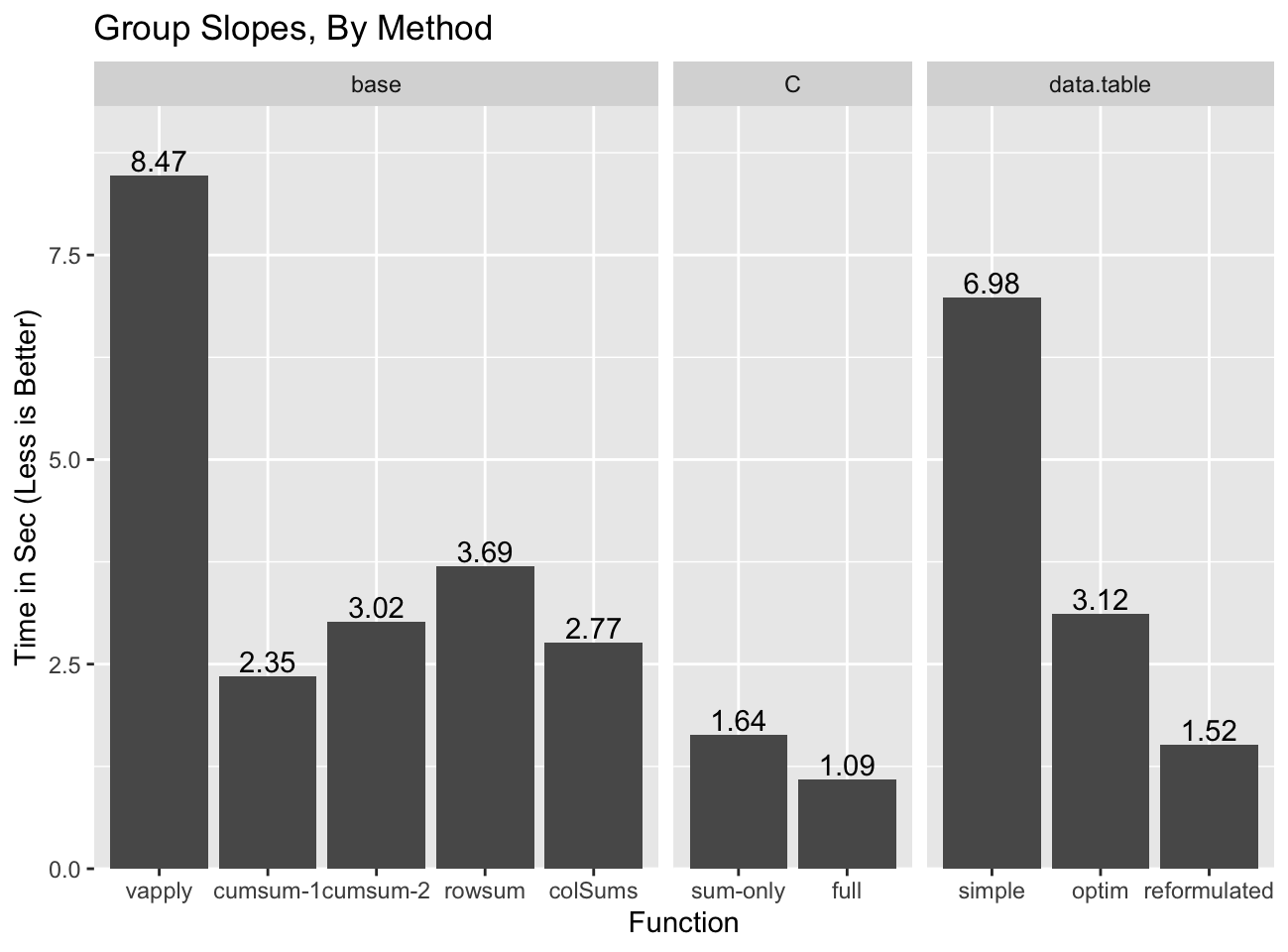
Even though rowsum was the fastest group sum implementation, it is the
slowest of the base options outside of split/vapply because none of the
computation components other than the re-ordering can be re-used. colSums
does pretty well and has the advantage of not suffering from the precision
issues of cumsum-18, and additionally of naturally handling NA and
non-finite values. cumsum-29 might be the best bet of the “base”
solutions as it is only slightly slower than colSums method, but should scale
better if there are some groups that are much larger than most10.
data.table gets pretty close to the C implementation, but only in the
reformulated form which comes with challenging precision issues.
That’s All Folks
Phew, finally done. I never imagined how out of hand some silly benchmarks
against data.table would get. I learned way more than I bargained for, and
come away from the whole thing with a renewed admiration for what R does: it
can often provide near-statically-compiled performance in an interpreted
language right out of the box11. It’s not always easy to
achieve this, but in many cases it is possible with a little thought and care.
This post is the last post of the Hydra Chronicles post series.
Appendix
Acknowledgments
These are post-specific acknowledgments. This website owes many additional thanks to generous people and organizations that have made it possible.
- Thomas Lin Pedersen and Tyler Morgan Wall for
gganimateandrayshader12 respectively with which I made thecolSumsgroup sum animation frames, and the FFmpeg team for FFmpeg with which I stitched the frames into the video. - Matt Dowle and the other
data.tableauthors for contributing the radix sort to R without which none of the fast group statistic methods would be fast. - Oleg Sklyar, Dirk Eddelbuettel, Romain François, etal. for
inlinefor easy integration of C code into ad-hoc R functions. - Hadley Wickham and the
ggplot2authors forggplot2with which I made many the plots in this post. - Simon Urbanek for the PNG package which I used in the process of manipulating the animation frames.
- Simon Garnier etal. for
viridisLite, and by extension thematplotlibteam from which it was ported. - Cynthia Brewer for color brewer palettes, one of which I used in some plots, and axismaps for the web tool for picking them.
Image Credits
- Hydra With Fedora(s), by Larry Wentzel, under CC BY-NC 2.0, haberdashery and haberdasher removed.
Session Info
sessionInfo()R version 3.6.0 (2019-04-26)
Platform: x86_64-apple-darwin15.6.0 (64-bit)
Running under: macOS Mojave 10.14.6
Matrix products: default
BLAS: /Library/Frameworks/R.framework/Versions/3.6/Resources/lib/libRblas.0.dylib
LAPACK: /Library/Frameworks/R.framework/Versions/3.6/Resources/lib/libRlapack.dylib
locale:
[1] en_US.UTF-8/en_US.UTF-8/en_US.UTF-8/C/en_US.UTF-8/en_US.UTF-8
attached base packages:
[1] stats graphics grDevices utils datasets methods base
other attached packages:
[1] data.table_1.12.2 gganimate_1.0.3 ggplot2_3.2.0 rayshader_0.11.5
loaded via a namespace (and not attached):
[1] rgl_0.100.19 Rcpp_1.0.1 prettyunits_1.0.2
[4] png_0.1-7 ps_1.3.0 assertthat_0.2.1
[7] rprojroot_1.3-2 digest_0.6.19 foreach_1.4.4
[10] mime_0.7 R6_2.4.0 imager_0.41.2
[13] tiff_0.1-5 plyr_1.8.4 backports_1.1.4
[16] evaluate_0.14 blogdown_0.12 pillar_1.4.1
[19] rlang_0.4.0 progress_1.2.2 lazyeval_0.2.2
[22] miniUI_0.1.1.1 rstudioapi_0.10 callr_3.2.0
[25] bmp_0.3 rmarkdown_1.12 desc_1.2.0
[28] devtools_2.0.2 webshot_0.5.1 servr_0.13
[31] stringr_1.4.0 htmlwidgets_1.3 igraph_1.2.4.1
[34] munsell_0.5.0 shiny_1.3.2 compiler_3.6.0
[37] httpuv_1.5.1 xfun_0.8 pkgconfig_2.0.2
[40] pkgbuild_1.0.3 htmltools_0.3.6 readbitmap_0.1.5
[43] tidyselect_0.2.5 tibble_2.1.3 bookdown_0.10
[46] codetools_0.2-16 crayon_1.3.4 dplyr_0.8.3
[49] withr_2.1.2 later_0.8.0 grid_3.6.0
[52] xtable_1.8-4 jsonlite_1.6 gtable_0.3.0
[55] magrittr_1.5 scales_1.0.0 cli_1.1.0
[58] stringi_1.4.3 farver_1.1.0 fs_1.3.1
[61] promises_1.0.1 remotes_2.0.4 doParallel_1.0.14
[64] testthat_2.1.1 iterators_1.0.10 tools_3.6.0
[67] manipulateWidget_0.10.0 glue_1.3.1 tweenr_1.0.1
[70] purrr_0.3.2 hms_0.4.2 crosstalk_1.0.0
[73] jpeg_0.1-8 processx_3.3.1 pkgload_1.0.2
[76] parallel_3.6.0 colorspace_1.4-1 sessioninfo_1.1.1
[79] memoise_1.1.0 knitr_1.23 usethis_1.5.0 Data
RNGversion("3.5.2"); set.seed(42)
n <- 1e7
n.grp <- 1e6
grp <- sample(n.grp, n, replace=TRUE)
noise <- rep(c(.001, -.001), n/2) # more on this later
x <- runif(n) + noise
y <- runif(n) + noise # we'll use this laterFunctions
sys.time
# Run `system.time` `reps` times and return the timing closest to the median
# timing that is faster than the median.
sys.time <- function(exp, reps=11) {
res <- matrix(0, reps, 5)
time.call <- quote(system.time({NULL}))
time.call[[2]][[2]] <- substitute(exp)
gc()
for(i in seq_len(reps)) {
res[i,] <- eval(time.call, parent.frame())
}
structure(res, class='proc_time2')
}
print.proc_time2 <- function(x, ...) {
print(
structure(
x[order(x[,3]),][floor(nrow(x)/2),],
names=c("user.self", "sys.self", "elapsed", "user.child", "sys.child"),
class='proc_time'
) ) }og_sum_col
The og_ prefix stands for “Ordered Group”.
Compute indices to embed group ordered data into a regular matrix:
og_embed_dat <- function(go) {
## compute run length encoding
g.rle <- rle(go)
g.lens <- g.rle[['lengths']]
max.g <- max(g.lens)
## compute padding
g.lens <- g.lens[-length(g.lens)]
g.pad <- max.g - g.lens + 1L
## compute embedding indices
id0 <- rep(1L, length(go))
id0[(cumsum(g.lens) + 1L)] <- g.pad
id1 <- cumsum(id0)
list(idx=id1, rle=g.rle)
}And use colSums to compute the group sums:
og_sum_col <- function(xo, embed_dat, na.rm=FALSE) {
## group sizes
rle.len <- embed_dat[['rle']][['lengths']]
## allocate embedding matrix
res <- matrix(0, ncol=length(rle.len), nrow=max(rle.len))
## copy data using embedding indices
res[embed_dat[['idx']]] <- xo
setNames(colSums(res, na.rm=na.rm), embed_dat[['rle']][['values']])
}og_sum_C
Similar to rowsum, except it requires ordered input, and it returns group
sizes as an attribute. Group sizes allow us to either compute means or recycle
the result statistic back to the input length.
This is a limited, lightly tested, implementation that only works for double x
values and relies completely on the native code to handle NA/Infinite values.
It will ignore dimensions of matrices, and has undefined behavior if any group
has more elements than than INT_MAX.
Inputs must be ordered in increasing order by group, with if it exists the NA group last. The NA group will be treated as a single group (i.e. NA==NA is TRUE).
og_sum_C <- function(x, group) {
stopifnot(
typeof(x) == 'double', is.integer(group), length(x) == length(group)
)
tmp <- .og_sum_C(x, group)
res <- setNames(tmp[[1]], tmp[[2]])
attr(res, 'grp.size') <- tmp[[3]]
res
}
.og_sum_C <- inline::cfunction(
sig=c(x='numeric', g='integer'),
body="
R_xlen_t len, i, len_u = 1;
SEXP res, res_x, res_g, res_n;
int *gi = INTEGER(g);
double *xi = REAL(x);
len = XLENGTH(g);
if(len != XLENGTH(x)) error(\"Unequal Length Vectors\");
res = PROTECT(allocVector(VECSXP, 3));
if(len > 1) {
// count uniques
for(i = 1; i < len; ++i) {
if(gi[i - 1] != gi[i]) {
++len_u;
} }
// allocate and record uniques
res_x = PROTECT(allocVector(REALSXP, len_u));
res_g = PROTECT(allocVector(INTSXP, len_u));
res_n = PROTECT(allocVector(INTSXP, len_u));
double *res_xi = REAL(res_x);
int *res_gi = INTEGER(res_g);
int *res_ni = INTEGER(res_n);
R_xlen_t j = 0;
R_xlen_t prev_n = 0;
res_xi[0] = 0;
for(i = 1; i < len; ++i) {
res_xi[j] += xi[i - 1];
if(gi[i - 1] == gi[i]) {
continue;
} else if (gi[i - 1] < gi[i]){
res_gi[j] = gi[i - 1];
res_ni[j] = i - prev_n; // this could overflow int; undefined?
prev_n = i;
++j;
res_xi[j] = 0;
} else error(\"Decreasing group order found at index %d\", i + 1);
}
res_xi[j] += xi[i - 1];
res_gi[j] = gi[i - 1];
res_ni[j] = i - prev_n;
SET_VECTOR_ELT(res, 0, res_x);
SET_VECTOR_ELT(res, 1, res_g);
SET_VECTOR_ELT(res, 2, res_n);
UNPROTECT(3);
} else {
// Don't seem to need to duplicate x/g
SET_VECTOR_ELT(res, 0, x);
SET_VECTOR_ELT(res, 1, g);
SET_VECTOR_ELT(res, 2, PROTECT(allocVector(REALSXP, 0)));
UNPROTECT(1);
}
UNPROTECT(1);
return res;
")g_slope_col
Compute the slope using the colSums based group sum. Notice
how we compute the embedding indices once, and re-use them for all four group
sums.
g_slope_col <- function(x, y, group) {
## order
o <- order(group)
go <- group[o]
xo <- x[o]
yo <- y[o]
## compute group means for x/y
emb <- og_embed_dat(go) # << Embedding
lens <- emb[['rle']][['lengths']]
ux <- og_sum_col(xo, emb)/lens # << Group Sum #1
uy <- og_sum_col(yo, emb)/lens # << Group Sum #2
## recycle means to input vector length and
## compute (x - mean(x)) and (y - mean(y))
gi <- rep(seq_along(ux), lens)
x_ux <- xo - ux[gi]
y_uy <- yo - uy[gi]
## Slope calculation
gs.cs <-
og_sum_col(x_ux * y_uy, emb) / # << Group Sum #3
og_sum_col(x_ux ^ 2, emb) # << Group Sum #4
setNames(gs.cs, emb[['rle']][['vaues']])
}
sys.time(g_slope_col(x, y, grp)) user system elapsed
2.268 0.497 2.765g_slope_C
This is a very lightly tested all C implementation of the group slope.
g_slope_C <- function(x, y, group) {
stopifnot(
typeof(x) == 'double', is.integer(group), length(x) == length(group),
typeof(y) == 'double', length(x) == length(y)
)
o <- order(group)
tmp <- .g_slope_C(x[o], y[o], group[o])
res <- setNames(tmp[[1]], tmp[[2]])
res
}
.g_slope_C <- inline::cfunction(
sig=c(x='numeric', y='numeric', g='integer'),
body="
R_xlen_t len, i, len_u = 1;
SEXP res, res_x, res_g, res_y;
int *gi = INTEGER(g);
double *xi = REAL(x);
double *yi = REAL(y);
len = XLENGTH(g);
if(len != XLENGTH(x)) error(\"Unequal Length Vectors\");
res = PROTECT(allocVector(VECSXP, 2));
if(len > 1) {
// First pass compute unique groups
for(i = 1; i < len; ++i) {
if(gi[i - 1] != gi[i]) {
++len_u;
} }
// allocate and record uniques
res_x = PROTECT(allocVector(REALSXP, len_u));
res_y = PROTECT(allocVector(REALSXP, len_u));
res_g = PROTECT(allocVector(INTSXP, len_u));
double *res_xi = REAL(res_x);
double *res_yi = REAL(res_y);
int *res_gi = INTEGER(res_g);
R_xlen_t j = 0;
R_xlen_t prev_i = 0, n;
// Second pass compute means
double xac, yac;
yac = xac = 0;
for(i = 1; i < len; ++i) {
xac += xi[i - 1];
yac += yi[i - 1];
if(gi[i - 1] == gi[i]) {
continue;
} else if (gi[i - 1] < gi[i]){
n = i - prev_i;
res_xi[j] = xac / n;
res_yi[j] = yac / n;
res_gi[j] = gi[i - 1];
prev_i = i;
yac = xac = 0;
++j;
} else error(\"Decreasing group order found at index %d\", i + 1);
}
xac += xi[i - 1];
yac += yi[i - 1];
n = i - prev_i;
res_xi[j] = xac / n;
res_yi[j] = yac / n;
res_gi[j] = gi[i - 1];
// third pass compute slopes
double xtmp, ytmp;
yac = xac = xtmp = ytmp = 0;
j = 0;
for(i = 1; i < len; i++) {
xtmp = xi[i - 1] - res_xi[j];
ytmp = yi[i - 1] - res_yi[j];
xac += xtmp * xtmp;
yac += ytmp * xtmp;
if(gi[i - 1] == gi[i]) {
continue;
} else {
res_xi[j] = yac / xac;
yac = xac = 0;
++j;
}
}
xtmp = xi[i - 1] - res_xi[j];
ytmp = yi[i - 1] - res_yi[j];
xac += xtmp * xtmp;
yac += ytmp * xtmp;
res_xi[j] = yac / xac;
SET_VECTOR_ELT(res, 0, res_x);
SET_VECTOR_ELT(res, 1, res_g);
UNPROTECT(3);
} else {
// Don't seem to need to duplicate x/g
SET_VECTOR_ELT(res, 0, x);
SET_VECTOR_ELT(res, 1, g);
SET_VECTOR_ELT(res, 2, PROTECT(allocVector(REALSXP, 0)));
UNPROTECT(1);
}
UNPROTECT(1);
return res;
")tapplycallslapplyinternally, notsapply, but the semantics of the defaultsimplify=TRUEcase are equivalent. Additionally, the simplification isn’t done withcas suggested by the diagram, but in this case with scalar return values fromsumit’s also semantically equivalent.↩I use single threaded timings as those are more stable, and it allows apples-to-apples comparisons. While it is a definite advantage that
data.tablecomes with its own built-in parallelization, enabling its use means the benchmarks are only relevant for R processes that are themselves not parallelized.↩rowsumreturns a matrix even in the one column case so we drop the dimensions withcto make the comparison tocolSumsmore obvious.↩We could have the function sort the inputs itself, but doing it this way allows us to compare to the other functions for which we pre-sort, and to re-use the ordering data when summarizing multiple variables.↩
I implemented a test version to test feasibility and it had comparable performance↩
With group-ordered data we can detect group transitions any time the value of the group vector changes. We can use that as a trigger to transfer the accumulator value to the result vector and reset it. We did something similar with our re-implementation of
uniquefor sorted data.↩sumtime is essentially all time that is neither ordering,rle, or embedding index calculation, so for some functions it includes steps other than just summing.↩Original single pass
cumsumbased group sum.↩cumsumbased group sum with second precision correcting pass. In this case we use the second pass for every one of the four group sums.↩Note we’ll really need to use the more complex and probably slightly slower version that handles NAs and non-finite values.↩
I consider ~3x close given that typically differences between statically compiled and interpreted coder are more on the order of ~10-100x.↩
I used
rayshaderprimarily to compute the shadows on the texture of the 3D plots. Obviously the idea of the 3Dggplotcomes fromrayshadertoo, but since I do not know how to control it precisely enough to merge the frames from its 3D plots into those ofgganimateI ended up using my own half-baked 3D implementation. I’ve recorded the code for the curious, but be prepared to recoil in horror. For an explanation of how the 3D rendering works see the Stereoscopic post.↩
